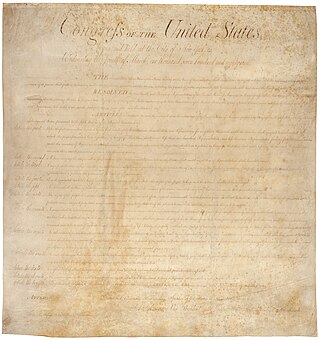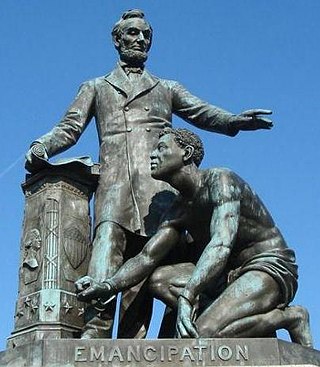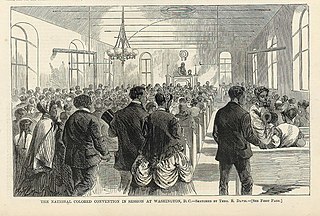Related Research Articles

Schuyler Colfax Jr. was an American journalist, businessman, and politician who served as the 17th vice president of the United States from 1869 to 1873, and prior to that as the 25th speaker of the House of Representatives from 1863 to 1869. Originally a Whig, then part of the short-lived People's Party of Indiana, and later a Republican, he was the U.S. representative for Indiana's 9th congressional district from 1855 to 1869.

Henry Wilson was the 18th vice president of the United States, serving from 1873 until his death in 1875, and a senator from Massachusetts from 1855 to 1873. Before and during the American Civil War, he was a leading Republican, and a strong opponent of slavery. Wilson devoted his energies to the destruction of "Slave Power", the faction of slave owners and their political allies which anti-slavery Americans saw as dominating the country.

Woodbridge Nathan Ferris was an American educator from New York, Illinois and Michigan who served as the 28th governor of Michigan and in the United States Senate as a Democrat. He was the founder and namesake of Ferris State University.

Morrison Remick "Mott" Waite was an American attorney, jurist, and politician from Ohio who served as the seventh chief justice of the United States from 1874 until his death in 1888. During his tenure, the Waite Court took a narrow interpretation of federal authority related to laws and amendments that were enacted during the Reconstruction Era to expand the rights of freedmen and protect them from attacks by white supremacy groups such as the Ku Klux Klan.

The Civil Rights Act of 1875, sometimes called the Enforcement Act or the Force Act, was a United States federal law enacted during the Reconstruction era in response to civil rights violations against African Americans. The bill was passed by the 43rd United States Congress and signed into law by President Ulysses S. Grant on March 1, 1875. The act was designed to "protect all citizens in their civil and legal rights", providing for equal treatment in public accommodations and public transportation and prohibiting exclusion from jury service. It was originally drafted by Senator Charles Sumner in 1870, but was not passed until shortly after Sumner's death in 1875. The law was not effectively enforced, partly because President Grant had favored different measures to help him suppress election-related violence against blacks and Republicans in the Southern United States.

Marshall Jewell was a manufacturer, pioneer telegrapher, telephone entrepreneur, world traveler, and political figure who served as 44th and 46th Governor of Connecticut, the US Minister to Russia, the 25th United States Postmaster General, and Republican Party National Chairman. Jewell, distinguished for his fine "china" skin, grey eyes, and white eyebrows, was popularly known as the "Porcelain Man". As Postmaster General, Jewell made reforms and was intent on cleaning up the Postal Service from internal corruption and profiteering. Postmaster Jewell helped Secretary of the Treasury Benjamin H. Bristow shut down and prosecute the Whiskey Ring. President Grant, however, became suspicious of Jewell's loyalty after Jewell fired a Boston postmaster over non payment of a surety bond and asked for his resignation.

Dorothy Irene Height was an African-American civil rights and women's rights activist. She focused on the issues of African-American women, including unemployment, illiteracy, and voter awareness. Height is credited as the first leader in the civil rights movement to recognize inequality for women and African Americans as problems that should be considered as a whole. She was the president of the National Council of Negro Women for 40 years. Height's role in the "Big Six" civil rights movement was frequently ignored by the press due to sexism. In 1974, she was named to the National Commission for the Protection of Human Subjects of Biomedical and Behavioral Research, which published the Belmont Report, a bioethics report in response to the infamous Tuskegee Syphilis Study.

The New Orleans massacre of 1866 occurred on July 30, when a peaceful demonstration of mostly Black Freedmen was set upon by a mob of white rioters, many of whom had been soldiers of the recently defeated Confederate States of America, leading to a full-scale massacre. The violence erupted outside the Mechanics Institute, site of a reconvened Louisiana Constitutional Convention. According to the official report, a total of 38 were killed and 146 wounded, of whom 34 dead and 119 wounded were Black Freedmen. Unofficial estimates were higher. Gilles Vandal estimated 40 to 50 Black Americans were killed and more than 150 Black Americans wounded. Others have claimed nearly 200 were killed. In addition, three white convention attendees were killed, as was one white protester.

Dean Park Taylor was an American attorney and politician from Troy, New York. A Republican, he was most notable for his service as a United States Congressman for 18 years (1943–1961) and chairman of the New York Republican State Committee (1953–1954).

The United States Bill of Rights comprises the first ten amendments to the United States Constitution. Proposed following the often bitter 1787–88 debate over the ratification of the Constitution and written to address the objections raised by Anti-Federalists, the Bill of Rights amendments add to the Constitution specific guarantees of personal freedoms and rights, clear limitations on the government's power in judicial and other proceedings, and explicit declarations that all powers not specifically granted to the federal government by the Constitution are reserved to the states or the people. The concepts codified in these amendments are built upon those in earlier documents, especially the Virginia Declaration of Rights (1776), as well as the Northwest Ordinance (1787), the English Bill of Rights (1689), and Magna Carta (1215).

The Emancipation Memorial, also known as the Freedman's Memorial or the Emancipation Group is a monument in Lincoln Park in the Capitol Hill neighborhood of Washington, D.C. It was sometimes referred to as the "Lincoln Memorial" before the more prominent national memorial was dedicated in 1922.

The presidency of Ulysses S. Grant began on March 4, 1869, when Ulysses S. Grant was inaugurated as the 18th President of the United States, and ended on March 4, 1877. The Reconstruction era took place during Grant's two terms of office. The Ku Klux Klan caused widespread violence throughout the South against African Americans. By 1870, all former Confederate states had been readmitted into the United States and were represented in Congress; however, Democrats and former slave owners refused to accept that freedmen were citizens who were granted suffrage by the Fifteenth Amendment, which prompted Congress to pass three Force Acts to allow the federal government to intervene when states failed to protect former slaves' rights. Following an escalation of Klan violence in the late 1860s, Grant and his attorney general, Amos T. Akerman, head of the newly created Department of Justice, began a crackdown on Klan activity in the South, starting in South Carolina, where Grant sent federal troops to capture Klan members. This led the Klan to demobilize and helped ensure fair elections in 1872. He was succeeded by fellow Republican Rutherford B. Hayes, who won the 1876 presidential election.

The Colored Conventions Movement, or Black Conventions Movement, was a series of national, regional, and state conventions held irregularly during the decades preceding and following the American Civil War. The delegates who attended these conventions consisted of both free and formerly enslaved African Americans, including religious leaders, businessmen, politicians, writers, publishers, editors, and abolitionists. The conventions provided "an organizational structure through which black men could maintain a distinct black leadership and pursue black abolitionist goals." Colored conventions occurred in thirty-one states across the United States and in Ontario, Canada. The movement involved more than five thousand delegates and tens of thousands of attendees.
The following is a timeline of the history of Washington, D.C., the capital city of the United States.

Robert James Harlan was a civil rights activist and politician in Cincinnati, Ohio in the 1870s-1890s. He was born a slave but was allowed free movement and employment on the plantation of Kentucky politician James Harlan, who raised him and may have been his father or half-brother. He became interested in horse racing as a young man and moved to California during the 1849 Gold Rush where he was very successful. In 1859 he moved to England to import racehorses from America and race them in England. He returned to the United States in 1869 during reconstruction. He became friends with Ulysses S. Grant and became involved in Republican politics. For the rest of his life, he was involved in city, state, and national African-American civil rights and political movements. In 1870 he became colonel of the Second Ohio Militia Battalion, a black state militia battalion in Cincinnati. In 1886, he became a member of the Ohio House of Representatives.

The Revolutionary People's Constitutional Convention (RPCC) was a conference organized by the Black Panther Party (BPP) that was held in Philadelphia from September 4–7, 1970. The goal of the Convention was to draft a new version of the United States Constitution and to unify factions of the radical left in the United States. The RPCC represented one of the largest gatherings of radical activists across movements and issues in the United States. The Convention was attended by a variety of organizations from the Black Power Movement, Asian American Movement, Chicano Movement, American Indian Movement, Anti-war movement, Women's Liberation, and Gay Liberation movements. Estimates of attendance range from 6,000 to 15,000. Attendees convened in workshops to draft declarations of demands related to various issues, which were ultimately intended to be incorporated into a new constitution which would function as the final vision of those movements. The RPCC also signified a shift in BPP focus from black self-defense to a broader revolutionary agenda. While conflicts did arise during the Philadelphia Convention, the conference was ultimately deemed a success by the Panthers. After the Philadelphia conference, attempts were made to reconvene to finalize and ratify the new constitution in Washington, DC a few months later but ultimately failed due to police interference and Panther disorganization.

Greene Shadrach Washington Lewis was a leader among African Americans and a state legislator in Alabama during the Reconstruction era 1868–1876. He represented Perry County, Alabama.
George Washington LeVere was an African American pastor, educator, abolitionist, and civil rights activist. As president of the African Civilization Society, LeVere met with President Abraham Lincoln and discussed the educational needs of freedmen. LeVere was a chaplain with the United States Colored Troops and served as a delegate to two Colored National Conventions and numerous Tennessee Republican Conventions. He was also the National Grand Master of the Prince Hall Freemasons from 1877 to 1886.

In the District of Columbia, the slave trade was legal from its creation until it was outlawed as part of the Compromise of 1850. That restrictions on slavery in the District were probably coming was a major factor in the retrocession of the Virginia part of the District back to Virginia in 1847. Thus the large slave-trading businesses in Alexandria, such as Franklin & Armfield, could continue their operations in Virginia, where slavery was more secure.
African Americans in Nebraska or Black Nebraskans are residents of the state of Nebraska who are of African American ancestry. With history in Nebraska from the Lewis and Clark Expedition through the Civil War, emancipation, the Reconstruction era, resurgence of white supremacy with the Ku Klux Klan and Jim Crow Laws, the Civil Right movement, into current times, African Americans have contributed vastly to the economics, culture, and substance of the state.
References
- ↑ Ogilvie, W. (May 29, 1873). "The National Equal Rights Convention, which met Dec. 9th, 1873, Washington, D.C." www.loc.gov.
- ↑ "The National Civil Rights Convention". The New York Times. December 14, 1873.
- ↑ "National Conventions · Colored Conventions Project Digital Records". omeka.coloredconventions.org.
- ↑ "Memorial of the National Convention of Colored Persons Praying to be Protected in Their Civil Rights: National Civil-Rights Convention, Washington, D.C., December, 1873". May 29, 1873 – via Google Books.
- ↑ Memorial of the national convention of colored persons praying to be protected in their civil rights: National Civil-Rights Convention, Washington, D.C., December, 1873. 43rd Congress, 1st Session, Senate ;mis. Doc. No. 21. [s.n.] May 29, 1873 – via Hathi Trust.
- 1 2 3 Friedlander, Alan; Gerber, Richard Allan (November 22, 2018). Welcoming Ruin: The Civil Rights Act of 1875. BRILL. ISBN 9789004384071 – via Google Books.